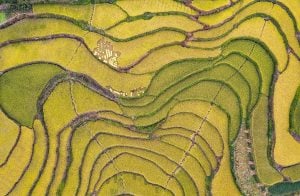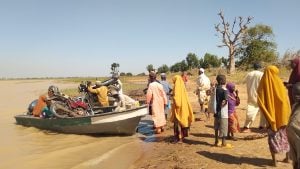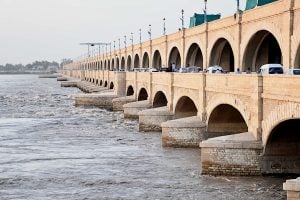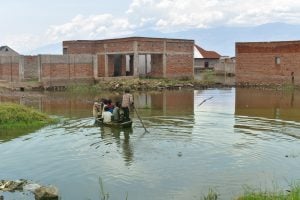Gaze into the ocean from the surface and you’ll be lucky to see a few tens of metres down. As for mapping the bottom, people have spent centuries developing tools, from early weighted lines to modern sonar.
But the map of the ocean floor is still patchy. Huge mountains can hide, unmapped, in the vast expanse, often only discovered by rare careful studies.
Helen Snaith is trying to change that. She is a senior data scientist at the National Oceanography Centre in the United Kingdom and the head of the Global Centre for the Seabed 2030 initiative.
The initiative, officially called the Nippon Foundation-GEBCO Seabed 2030 Project, aims to produce a complete map of the ocean floor by 2030.
Snaith spoke to Dialogue Earth about why this goal is so important.
The conversation has been edited for length and clarity.
Dialogue Earth: For you, what is the driving reason for doing this mapping?
Helen Snaith: Personally, it’s because I’m a data nerd, and I think data is great!
But from a slightly wider perspective, the research that it underpins is the fundamental reason. The Antarctic polar current, the biggest ocean current in the world, is constrained to go through a particular fracture zone [a kind of underwater valley]. It doesn’t move north and south, because it’s fixed in that one position, and that is totally controlled by the bathymetry [the mapping of underwater terrain]. For tsunami predictions, if you get the bathymetry wrong, you will completely mistime the tsunami wave, the height of the wave and the impact it has.
The bathymetry is just such a fundamental underpinning observation to help you understand absolutely anything else you want to measure in the ocean.
Seabed 2030 is aiming for a map of “adequate” resolution – what does that mean?
Having decided that the aim of the project was to map the ocean by 2030, the first thing we had to determine was: what do we mean by “map”?
The whole ocean floor is already mapped to a low resolution; we’ve already got the satellite bathymetry everywhere. What we wanted to do is map it in finer detail and greater accuracy.
What we did right at the very beginning of the project was to look at what is technically feasible, using the kind of instrumentation that is typically available on a modern research vessel: multibeam echo sounders. They work on a signal that’s transmitted down from the ship. The deeper the water, the more spread out the signal gets.
The resolution is also affected by the speed of your ship. For deep ocean, a resolution of [one depth reading in a square of] around 400 metres is typically what you will get. We can get 100 metres or better in shallow water.
Why can’t you just use the satellite-measured depths?
The depth of water deadens the signal, which means that it will only ever detect big, big features. There also has to be a gravity signal, so if you get a lump of low-density rock that’s sitting in higher-density rock, it doesn’t show up.
If there’s an indication in the satellite-derived imagery that there’s something there, we’ve got a kind of fuzzy picture of something. Every time you go and get the multibeam imagery, you see there is so much detail.
People have gone to places where there were no seamounts indicated in the satellite-derived data, or maybe just small features, and run expeditions over them. And there have been huge seamounts that come within a couple hundred metres of the surface from 6,000 metres.
Every time you measure, you find something that you weren’t necessarily expecting.
But you’re not doing this survey work yourself, right?
No, no. Putting ships out there is a very expensive thing to do, and that’s well outside the amount of funding we’ve got. We go out to whoever’s got data and try and convince them to give it to us, and we also say: “If you are going out there and measuring something else, please can you measure the bathymetry as well and send it to us?”
It may be being measured as part of research operations, and that’s the easiest target for us. Data that’s being collected by hydrographic offices, or for particular countries, is slightly harder to get hold of because they’re funded for the benefit of the nation. Then we go into the whole world of commercial data. The other area that we are starting to look at quite a lot is autonomous data-collection systems.
Where has the best and the worst data at the moment? Are there any big gaps?
In very simplistic terms, the north is better mapped. Most western, developed countries, if they have coasts, have a hydrographic survey organisation. But quite a lot of states don’t have the resources to do it.
One of the straplines we use is that you can’t protect what you don’t know about. If you don’t know that there are particular features that are likely to be supporting particular types of marine life or fish, you don’t know to protect them. You don’t know what resources you’ve got.
This is the level in a lot of coastal states, especially those with large ocean territories. The other issue with any kind of island state is that the [ratio of] coastline compared to your size, is always going to be high, and the number of people who are able to contribute financially to each square kilometre of ocean floor that you’re trying to look after will be quite small. So even if they were as rich as the northern states, the sums still wouldn’t add up.
In 2017, when you started, about 6% of the floor was adequately mapped. Now, you’re at around 25%. How is the project progressing?
The main addition was in the first couple of years, which was effectively getting together and into the grid all of the data that have been sitting around in multiple locations. The increases we’re getting now is a combination of new mapping and finding old data that haven’t yet been made available.
We were hoping it was going to speed up, and it’s actually slowing down. The trajectory at the moment is not leading us to believe it’s going to be finished by 2030; we are going to require a continued effort beyond that.
What do you think is the biggest challenge in all of this?
Apart from the fact that the ocean is big, fundamentally, water makes it really difficult to measure. This is why there are the statements that we know more about the shape of Mars than we do about the shape of the sea floor: Mars doesn’t have water on it. Measuring shapes in a vacuum, or even in air, is quite easy.
Clearly, the easiest way to get a global topography would be to drain the oceans, measure it, and stick the water back. That’s not terribly feasible.
But once you get past “it’s just fundamentally hard”, it’s a prioritisation issue. There’s a limited amount of resource for doing measurements in the ocean. It’s a resource prioritisation and political will issue.











